Page 216 of 520
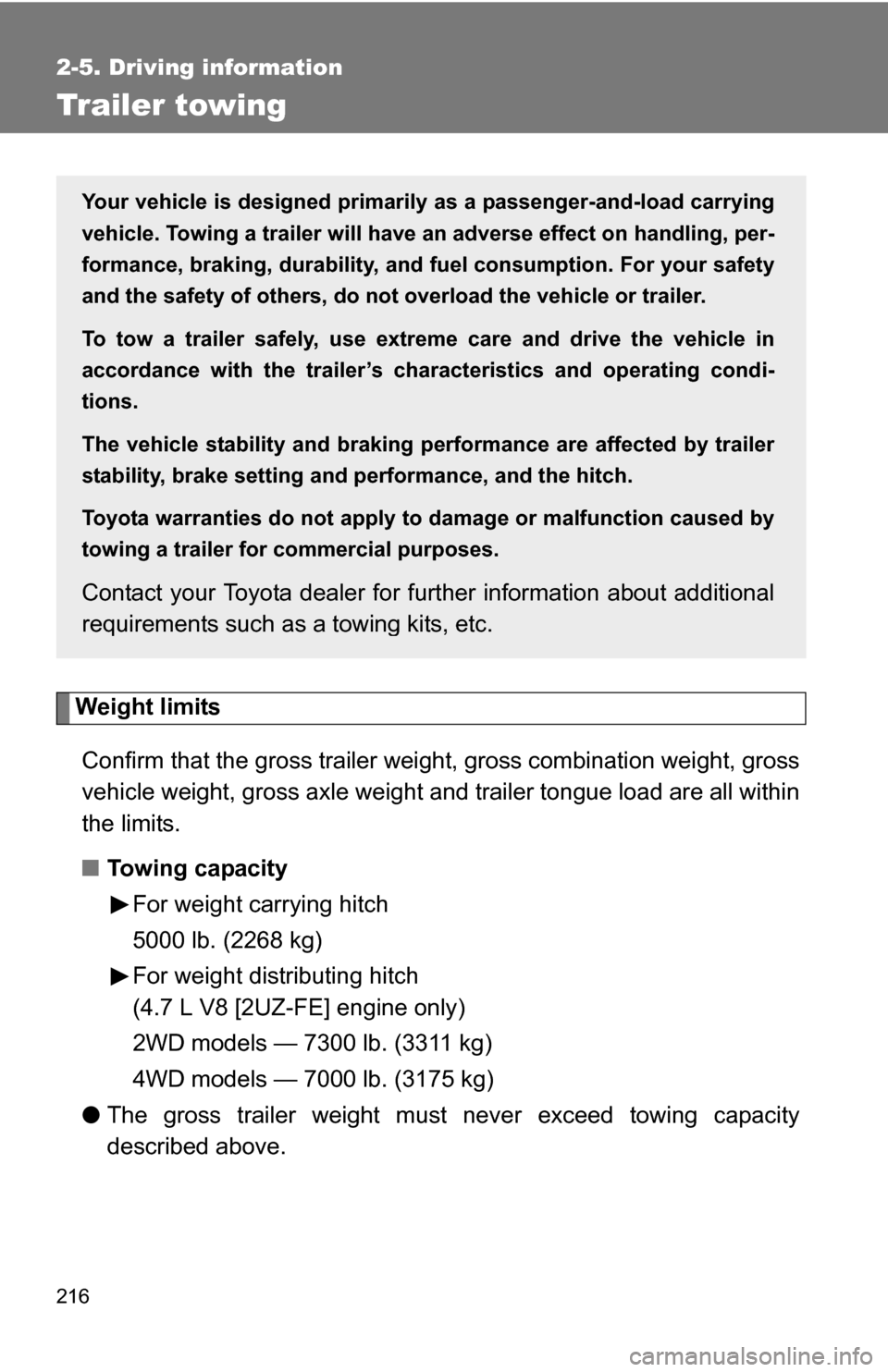
216
2-5. Driving information
Trailer towing
Weight limitsConfirm that the gross trailer weight, gross combination weight, gross
vehicle weight, gross axle weight and trailer tongue load are all within
the limits.
■ Towing capacity
For weight carrying hitch
5000 lb. (2268 kg)
For weight distributing hitch
(4.7 L V8 [2UZ-FE] engine only)
2WD models — 7300 lb. (3311 kg)
4WD models — 7000 lb. (3175 kg)
● The gross trailer weight must never exceed towing capacity
described above.
Your vehicle is designed primarily as a passenger-and-load carrying
vehicle. Towing a trailer will have an adverse effect on handling, per-
formance, braking, durability, and fu el consumption. For your safety
and the safety of others , do not overload the vehicle or trailer.
To tow a trailer safely, use extreme care and drive the vehicle in
accordance with the trailer’s char acteristics and operating condi-
tions.
The vehicle stability and braking performance are affected by trailer
stability, brake setting and performance, and the hitch.
Toyota warranties do not apply to damage or malfunction caused by
towing a trailer for commercial purposes.
Contact your Toyota dealer for fu rther information about additional
requirements such as a towing kits, etc.
Page 218 of 520
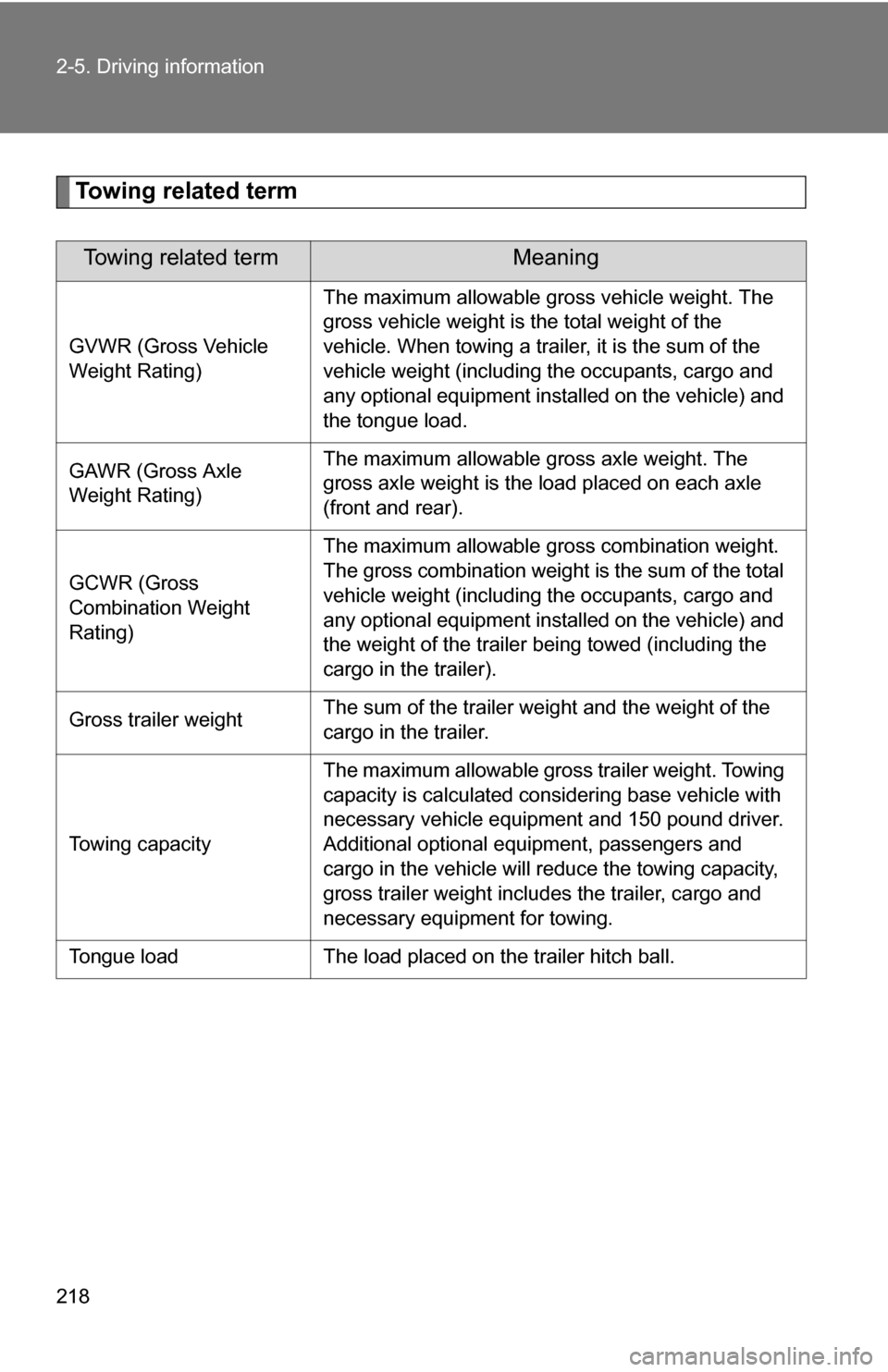
218 2-5. Driving information
Towing related term
Towing related termMeaning
GVWR (Gross Vehicle
Weight Rating)
The maximum allowable gross vehicle weight. The
gross vehicle weight is the total weight of the
vehicle. When towing a trailer, it is the sum of the
vehicle weight (including the occupants, cargo and
any optional equipment installed on the vehicle) and
the tongue load.
GAWR (Gross Axle
Weight Rating)The maximum allowable gross axle weight. The
gross axle weight is the load placed on each axle
(front and rear).
GCWR (Gross
Combination Weight
Rating)
The maximum allowable gross combination weight.
The gross combination weight is the sum of the total
vehicle weight (including the occupants, cargo and
any optional equipment installed on the vehicle) and
the weight of the trailer being towed (including the
cargo in the trailer).
Gross trailer weightThe sum of the trailer weight and the weight of the
cargo in the trailer.
Towing capacity
The maximum allowable gross trailer weight. Towing
capacity is calculated considering base vehicle with
necessary vehicle equipment and 150 pound driver.
Additional optional equipment, passengers and
cargo in the vehicle will reduce the towing capacity,
gross trailer weight includes the trailer, cargo and
necessary equipment for towing.
Tongue loadThe load placed on the trailer hitch ball.
Page 219 of 520
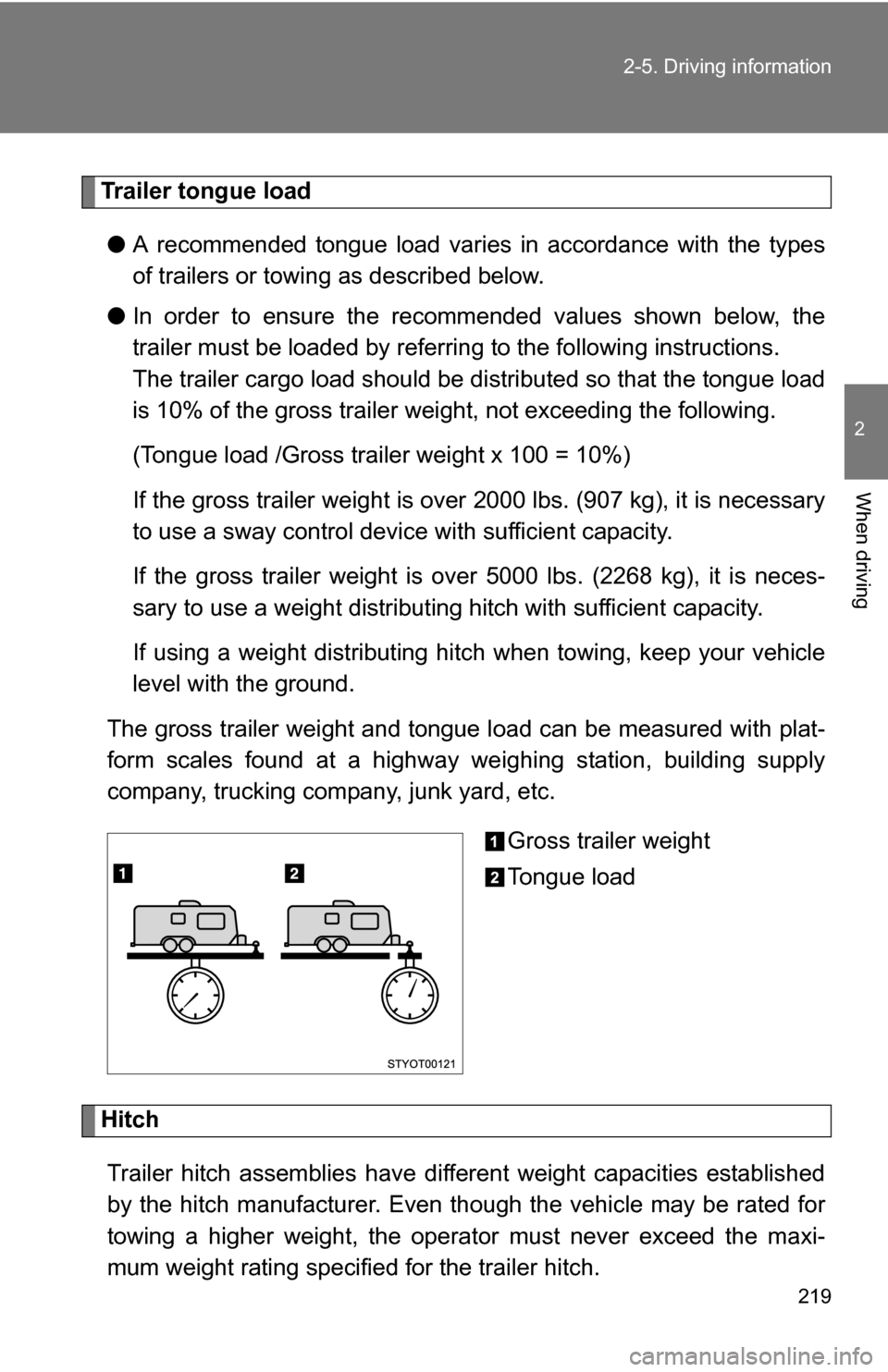
219
2-5. Driving information
2
When driving
Trailer tongue load
● A recommended tongue load varies in accordance with the types
of trailers or towing as described below.
● In order to ensure the recommended values shown below, the
trailer must be loaded by referring to the following instructions.
The trailer cargo load should be di stributed so that the tongue load
is 10% of the gross trailer weight, not exceeding the following.
(Tongue load /Gross trailer weight x 100 = 10%)
If the gross trailer weight is over 2000 lbs. (907 kg), it is necessary
to use a sway control device with sufficient capacity.
If the gross trailer weight is over 5000 lbs. (2268 kg), it is neces-
sary to use a weight distributing hitch with sufficient capacity.
If using a weight distributing hitch when towing, keep your vehicle
level with the ground.
The gross trailer weight and tongue l oad can be measured with plat-
form scales found at a highway weighing station, building supply
company, trucking company, junk yard, etc.
Gross trailer weight
Tongue load
Hitch
Trailer hitch assemblies have different weight capacities established
by the hitch manufacturer. Even th ough the vehicle may be rated for
towing a higher weight, the operat or must never exceed the maxi-
mum weight rating specified for the trailer hitch.
Page 225 of 520
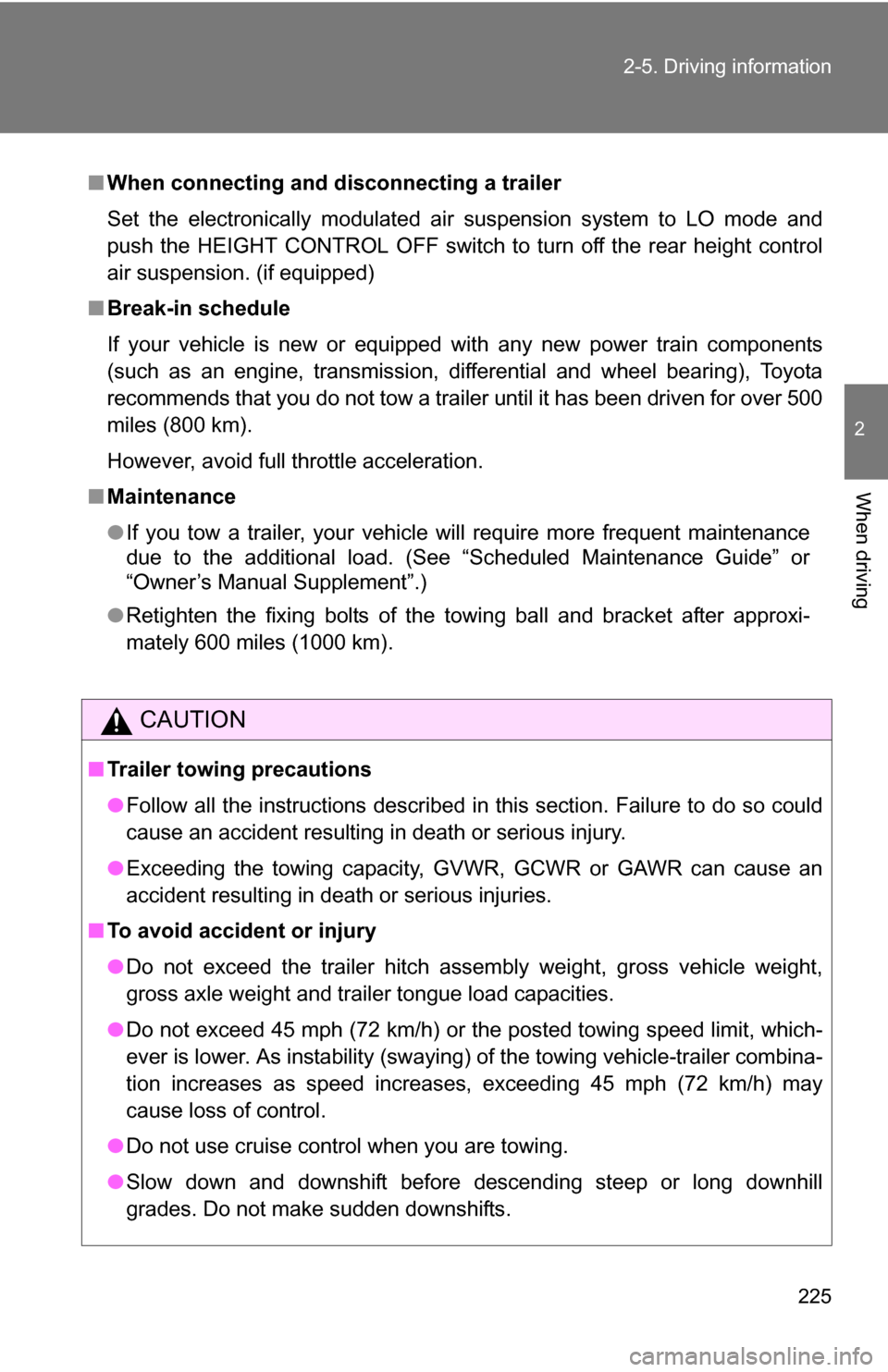
225
2-5. Driving information
2
When driving
■
When connecting and disconnecting a trailer
Set the electronically modulated air suspension system to LO mode and
push the HEIGHT CONTROL OFF switch to turn off the rear height control
air suspension. (if equipped)
■ Break-in schedule
If your vehicle is new or equipped with any new power train components
(such as an engine, transmission, differential and wheel bearing), Toyota
recommends that you do not tow a trailer until it has been driven for over 500
miles (800 km).
However, avoid full throttle acceleration.
■ Maintenance
●If you tow a trailer, your vehicle will require more frequent maintenance
due to the additional load. (See “Scheduled Maintenance Guide” or
“Owner’s Manual Supplement”.)
● Retighten the fixing bolts of the towing ball and bracket after approxi-
mately 600 miles (1000 km).
CAUTION
■Trailer towing precautions
●Follow all the instructions described in this section. Failure to do so could
cause an accident resulting in death or serious injury.
● Exceeding the towing capacity, GVWR, GCWR or GAWR can cause an
accident resulting in death or serious injuries.
■ To avoid accident or injury
●Do not exceed the trailer hitch assembly weight, gross vehicle weight,
gross axle weight and trailer tongue load capacities.
● Do not exceed 45 mph (72 km/h) or the posted towing speed limit, which-
ever is lower. As instability (swaying) of the towing vehicle-trailer combina-
tion increases as speed increases, exceeding 45 mph (72 km/h) may
cause loss of control.
● Do not use cruise control when you are towing.
● Slow down and downshift before descending steep or long downhill
grades. Do not make sudden downshifts.
Page 391 of 520

391
4-3. Do-it-yourself maintenance
4
Maintenance and care
■If the tread wears down below 0.16 in. (4 mm) on snow tires
The effectiveness of snow tires is lost.
■Maximum load of tire
Check that the maximum load of the re
placed tire is greater than 1/2 of
the Gross Axle Weight Ratings (GAWR) of either the front axle or the
rear axle, whichever is greater.
As for the maximum load of the tire, see the load limit at maximum cold
tire inflation pressure mentioned on the sidewall of the tire, and as for the
Gross Axle Weight Ratings (GAWR) , see the Certification Label.
( P. 395, 471, 484).
■Tire types
1 Summer tires
Summer tires are high-speed performance tires best suited to highway
driving under dry conditions. Since summer tires do not have the same
traction performance as snow tire s, summer tires are inadequate for
driving on snow-covered or icy roads. For driving on snow-covered
roads or icy roads, the use of snow tires is recommended. When
installing snow tires, be sure to replace all four tires.
2 All season tires
All season tires are designed to provide better traction in snow and to
be adequate for driving in most winter conditions, as well as for use
year round. All season tires, however, do not have adequate traction
performance compared with snow tires in heavy or loose snow. Also,
all season tires fall short in acceleration and handling performance
compared with summer tires in highway driving.
3Snow tires For driving on snow-covered roads or icy roads, we recommend using
snow tires. If you need snow tires, select tires of the same size, con-
struction and load capacity as the or iginally installed tires. Since your
vehicle has radial tires as original equipment, make sure your snow
tires also have radial construction. Do not install studded tires without
first checking local regulations for possible restriction. Snow tires
should be installed on all wheels. ( P. 213)
Page 398 of 520

398
4-3. Do-it-yourself maintenance
Wheels
■When replacing wheels
The wheels of your Toyota are equipped with tire pressure warning
valves and transmitters that allow the tire pressure warning system to
provide advanced warning in the event of a loss in tire inflation pressure.
Whenever wheels are replaced, the tire pressure warning valves and
transmitters must be installed. (P. 390)
If a wheel is bent, cracked or heavily corroded, it should be
replaced.
Otherwise, the tire may separate from the wheel or cause loss of
handling control.
■ Wheel selection
When replacing wheels, care should be taken to ensure that
they are equivalent to those removed in load capacity, diameter,
rim width, and offset.
Replacement wheels are available at your Toyota dealer.
Toyota does not recommend using:
●Wheels of different sizes or types
● Used wheels
● Bent wheels that have been straightened
■ Aluminum wheel precautions (if equipped)
●Use only Toyota wheel nuts and wrench designed for use with
your aluminum wheels.
● When rotating, repairing or changing your tires, check that the
wheel nuts are still tight after driving 1000 miles (1600 km).
● Be careful not to damage the aluminum wheels when using
tire chains.
● Use only Toyota genuine balance weights or equivalent and a
plastic or rubber hammer when balancing your wheels.
Page 470 of 520
470
6-1. Specifications
Maintenance data (fuel, oil level, etc.)
Dimensions and weight
1: Unladen vehicle2: 2WD models3: 4WD models4: With roof rails5: With rear spoiler6: With rear height control air suspension7: With 5 occupants8: With 7 occupants
Overall length189.2 in. (4805 mm)
Overall width75.2 in. (1910 mm)
Overall height1
71.7 in. (1820 mm)2 or 3,4
70.9 in. (1800 mm)2,3,5
69.1 in. (1755 mm)2,3
71.1 in. (1805 mm)2 or 3,4,6
70.3 in. (1785 mm)2 or 3,5,6
68.5 in. (1740 mm)2 or 3,6
Wheelbase109.8 in. (2790 mm)
Front tread 62.0 in. (1575 mm)
Rear tread62.0 in. (1575 mm)
Vehicle capacity weight
(Occupants + luggage) 950 lb. (431 kg)7
1050 lb. (477 kg)8
Towing capacity
(Trailer weight + cargo) For weight carrying hitch
5000 lb. (2268 kg)
For weight distributing hitch
(4.7 L V8 [2UZ-FE] engine only)
2WD models: 7300 lb. (3311kg)
4WD models: 7000 lb. (3175 kg)
Luggage compartment load
capacity
200 lb. (91 kg)7
0 lb. (0 kg)8
Page 474 of 520
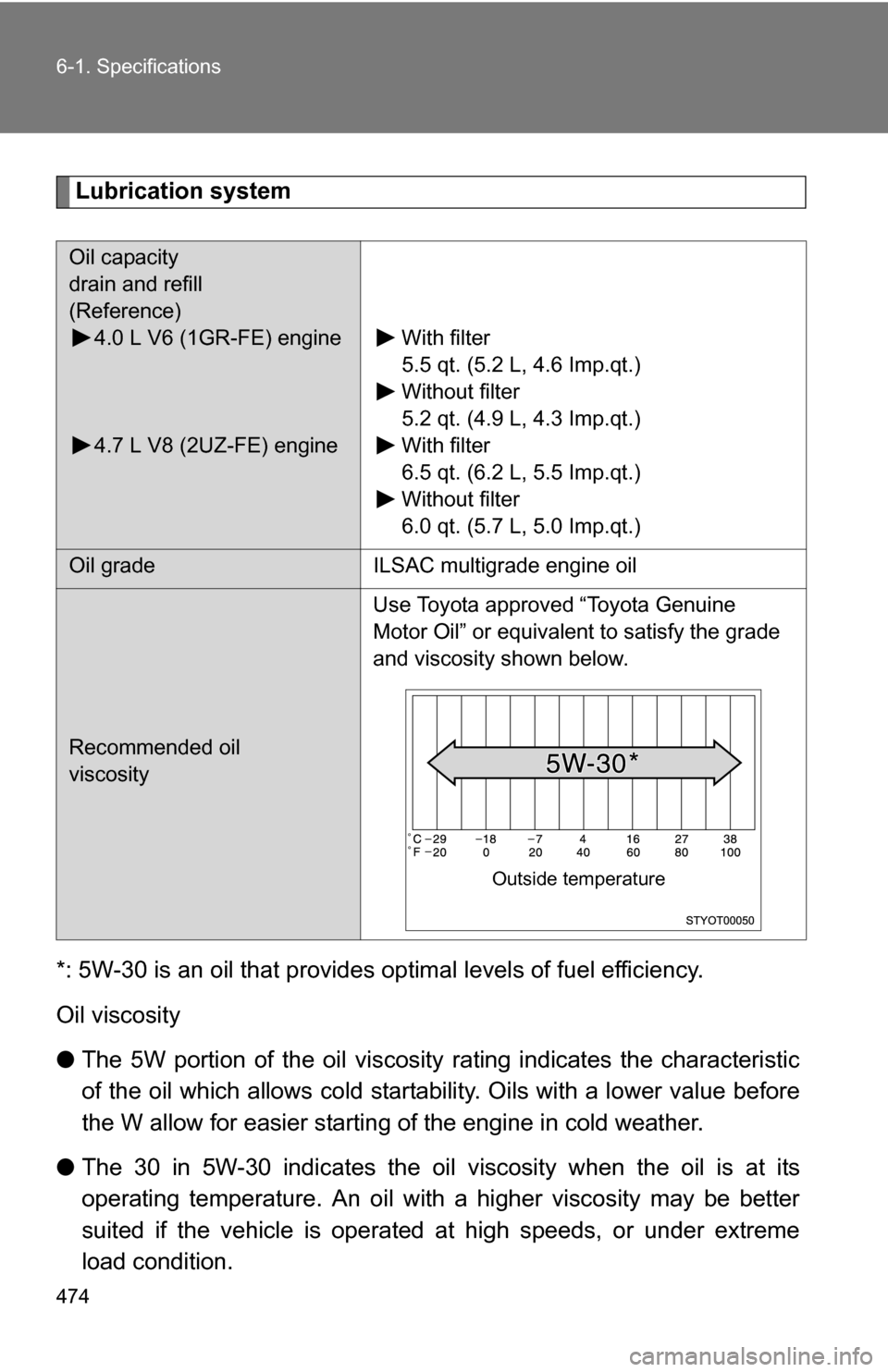
474 6-1. Specifications
Lubrication system
*: 5W-30 is an oil that provides optimal levels of fuel efficiency.
Oil viscosity
● The 5W portion of the oil viscosity rating indicates the characteristic
of the oil which allows cold startab ility. Oils with a lower value before
the W allow for easier starting of the engine in cold weather.
● The 30 in 5W-30 indicates the oil viscosity when the oil is at its
operating temperature. An oil with a higher viscosity may be better
suited if the vehicle is operated at high speeds, or under extreme
load condition.
Oil capacity
drain and refill
(Reference)
4.0 L V6 (1GR-FE) engine
4.7 L V8 (2UZ-FE) engine With filter
5.5 qt. (5.2 L, 4.6 Imp.qt.)
Without filter 5.2 qt. (4.9 L, 4.3 Imp.qt.)
With filter 6.5 qt. (6.2 L, 5.5 Imp.qt.)
Without filter 6.0 qt. (5.7 L, 5.0 Imp.qt.)
Oil grade ILSAC multigrade engine oil
Recommended oil
viscosityUse Toyota approved “Toyota Genuine
Motor Oil” or equivalent to satisfy the grade
and viscosity shown below.
Outside temperature